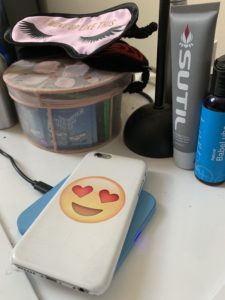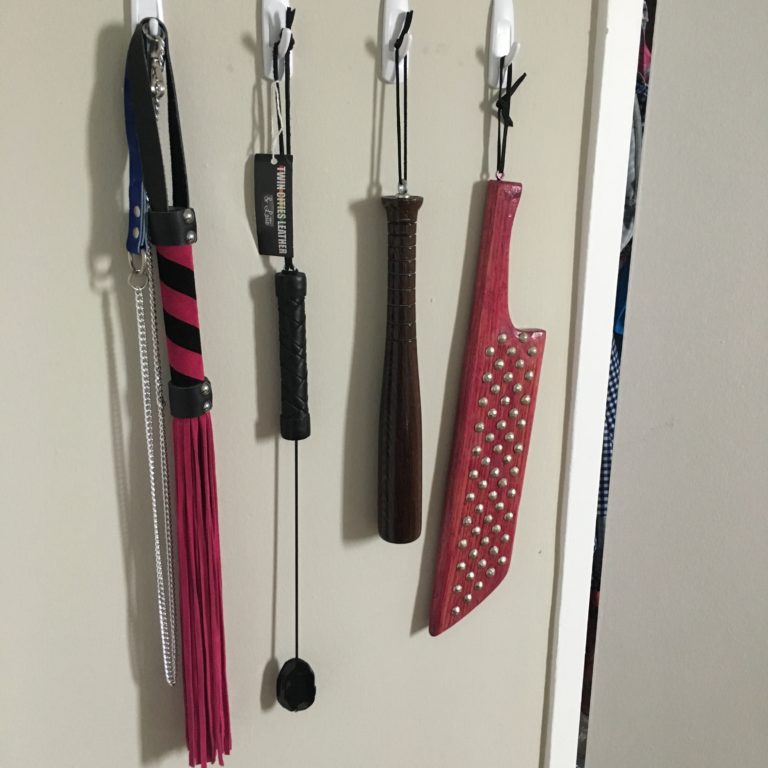 Maybe I shouldn’t have arrived so early. Why do I always do this? I glance over my shoulder at the door again. Maybe he’ll show up in five minutes. Maybe he’ll show up now.
Maybe I shouldn’t have arrived so early. Why do I always do this? I glance over my shoulder at the door again. Maybe he’ll show up in five minutes. Maybe he’ll show up now.
I always get nervous before interviews, even though I’ve been doing the whole professional-sex-journalist thing for going-on-7 years now. It’s just stagefright, harmless jitters, but it happens like clockwork. It’s why I rolled up to the Library Bar 10 minutes early. It’s why I keep sneaking peeks at the door.
Is that him? He’s wearing a dark button-down shirt. He’s looking my way. He’s smiling and waving. (He is my partner.) He’s coming over to sit next to me. (He is my partner.) He’s shaking my hand and saying, “Hi, I’m mb.” (I know who he is. He is my partner.)
Let me back up for a second. Months ago, when discussing potential roleplay scenarios, my boyfriend and I struck upon the idea of a journalist/source roleplay. I am a journalist, after all, and he is a semi-frequent media interviewee, being a tech fancyboy in New York, so we’re already comfortable in these roles.
Initially we envisioned it as a scene of strategic outsmarting, psychological manipulation, me trying to get info out of him for an investigative exposé and him trying to keep me at arm’s length. But the more we thought about it and discussed it, the more we wanted it to be a different type of scene entirely. We still wanted to play ourselves – me, a reporter; him, a tech CEO – but our focus shifted more toward the flirtation and chemistry that could naturally develop during an interview.
Storytelling dynamo Claire AH has talked often about how roleplay – which she calls “sexy improv” – can be an opportunity to explore ways you and your partner didn’t meet, but could’ve. She sometimes envisions, for example, having met her musician husband by being a groupie of his band, rather than on OkCupid. I love this idea, and how it allows you to re-access a state of charged unfamiliarity with your partner, flirting in double entendres and meaningful glances in ways you can’t do as readily when you’ve been dating for months or years.
Having defined our goals for the scene, BF and I started emailing back and forth, the way we would if we were actually setting up an interview with a stranger. My character needed to speak to an app developer for a story – and his character, it so happened, would be in Toronto for a “conference” soon. We settled on a day, time, and location. I started prepping my questions. It all began feeling very real.
Back to the Library Bar. “Hi, I’m mb,” this ridiculously handsome man says, grabbing my hand in a firm, CEO-appropriate handshake. “I’m Kate,” I reply. “Nice to finally meet you!”
He sits down next to me at the bar. (Was the bar the right spot to choose? Is it more professional to sit opposite a source, at a table?) He asks me what I’m drinking. (A Bulleit bourbon on the rocks. One of my fave orders when I’m trying to impress a dude who probably knows more than me about such things.) He orders an old fashioned. We small-talk about how he’s enjoying Toronto, what he’s been up to, what he thinks of his hotel.
Then he asks me what my piece is about, and I brighten. “So… It’s for Playboy. Ever heard of it?”
He laughs. “I only read it for the articles.”
“Well, great, ’cause I’m writing one of those articles! It’s about how I think nerds are better in bed.” I watch his eyes widen. We didn’t discuss this in our pre-interview emails. Sometimes I prefer to take sources by surprise. “I spoke to a web dev; I spoke to a game dev; I needed to speak to an app dev. So, thanks for agreeing to talk to me!” He is immediately on board, engaged and listening hard. I flip open my notebook to my list of questions. I begin.
“Do you think nerds are, on average, better in bed?” “Which subsets of the tech community do you think would be especially sexually skilled?” “What sexual acts do you think programmers would tend to be good at?”
His answers are measured, thoughtful, yet enthusiastic and off-the-cuff. He posits theories, tells stories from his own life, and cites thinkers he admires, like Michael Lopp and Evie Lupine. His blue eyes flash with intelligence and wit. Occasionally, when I ask him something, he gives me this pure-of-heart little smirk and says, “Good question!” I wonder if he can see how much it melts me when he compliments my competence, even though I’m a grown-ass journalist who knows her shit and knows her worth.
The thing about being a sex writer is, there will be opportunities for interviews to get flirty. In 99% of cases, I neither want this outcome nor think it’s smart to pursue it; it’s unprofessional, usually unwanted (by one or both parties), skews the story, and can get messy.
But this app mogul on the barstool next to me is… very cute. And he has been essentially selling himself to me as a promising hookup for the past hour. And he keeps reaching out to gently shove my shoulder to make a point, or holding my gaze a little too long while describing skilful fingerbanging. At one point he loses his train of thought mid-sentence and says, “Sorry, that dress is just… really good.” It’s a new one, vintage Betsey Johnson. “It’s kind of a ‘professional reporter lady’ dress,” I say, blushing, and he shoots back, “More like a ‘turning on a source’ dress. Wow.” I laugh and hide my warm face behind one shy hand.
I’ve asked all my questions, taken all my notes, and closed my notebook. “Want to get another drink, now that you’re off the clock?” he offers, so easily, and we order two more cocktails from the busy bartender. Flipping the script, this articulate interviewee asks me about my work – what I like about it, what I don’t – and I mention, in passing, that it can get complicated when a source wants to fuck me and I’m not into it. Or when I want to fuck a source, but my editor isn’t into it. “So is this the type of assignment where you might sleep with a source, or no?” he asks innocently, and I practically choke on my drink.
As the alcohol plies us further, we get to talking about FetLife: neither of us use it much, and he knows some nerds who are trying to build a better alternative. “What’s on your fetishes list?” he wonders, and I wrack my brain for the answer least likely to freak out this near-stranger. “Uhh, spanking?” I try, and he bites his lip like a sadistic Cheshire cat. “I actually have some impact implements up in my hotel room,” he mentions, so casually, and that room is now the only place I want to be.
He offers me a sip of his martini. “Ooh, that’s a daddy drink,” I say when I try it. “What does that mean?!” he asks with a quizzical smile. “Oh, you know, like something a daddy would drink.” I hide behind my glass when he intuits effortlessly, “Oh, so you’re into DD/lg, then.”
He’s getting closer and closer to me, as we’re getting tipsier and flirtier and farther off the path of our initial conversation. He’s got his arm draped over the back of my chair, and is gazing into my eyes like nobody else in this crowded bar exists. I lose my words, lose my breath. “Kiss me,” he says, out of nowhere, and I do, because I need to.
At some point we decide that yes, I will go up to his room with him – and I will disclose this key information to my editor when I file the story. We settle up and amble to the elevator. Inside, he pushes me against a wall and kisses me, like he’s wanted to do that ever since he first saw me from across the bar.
 If you’re interested in trying a roleplay like this – in person, out in public, pretending not to know each other – here are some tips I took away from our first attempt that I think might be useful to you too:
If you’re interested in trying a roleplay like this – in person, out in public, pretending not to know each other – here are some tips I took away from our first attempt that I think might be useful to you too:
• Define your intentions. As with any kink endeavor, it’s good to make sure you and your partner are hoping to get something similar out of the scene, or at least that your hopes for the scene are compatible. My partner and I are both into flirting, and knowing that that was the primary intention of our roleplay allowed us to focus on that aspect fully and enjoy it even more.
• Set the stage. Whatever the scenario you choose for your roleplay – meeting someone new at a bar; striking up a convo with the stranger beside you at the theatre; going on a first Tinder date – prepare for that situation however you normally would. It’ll help get you into the appropriate headspace. For this roleplay, for example, my partner and I exchanged businessy emails weeks beforehand, and I prepped and researched just as I would for an actual interview.
• Dress the part. Clothes and other self-presentation details can help you get into character, even if your “character” is just an alternate-universe version of yourself. This can be especially helpful if you and your partner hang out earlier in the day and then go do a roleplay; my partner changed his shirt before our interview, for example, and it was a small thing that nonetheless made him feel like a slightly different person to me. You can also change stuff like your perfume, jewelry, and hairstyle, to set your character apart from your regular self.
• Do something, dammit. Decide on a concrete task or interaction that the roleplay will center around; don’t just show up at the location and stand around awkwardly. Our roleplay hinged on an interview, and I did an actual interview, because I knew it would make me less nervous and would lend some purpose and direction to the scene. Even if your roleplay is pretty straightforward, like a chance meeting with a cute stranger at a bar, have some idea of what you want to do: bring a book to read, or have a specific drink you want to try, or a specific occasion your character is celebrating, or something.
• Commit to the scene. The #1 question I got from my Twitter followers about this roleplay was essentially, “How do you stay in character?” and the answer is… just decide to stay in character. As with dirty talk – not to mention improv, which roleplay essentially is! – you will actually seem (and feel) sillier if you half-ass it. Hopefully your partner is someone you trust not to laugh at you for wholeheartedly throwing yourself into the scene – because if that’s all they want to do, why do the roleplay at all?!
• Making mistakes is okay. A few times during our roleplay, my partner and I accidentally referenced some of our real-life inside jokes, or responded to things how we ourselves – but not our “characters” – would respond. Slip-ups are bound to happen, especially if you’re not accustomed to this type of improvisation. That’s fine. There is nothing wrong with laughing for a moment at the mistake you’ve made and then moving on with the scene. The entire narrative doesn’t have to fall apart just because you screwed up for a second.
• Debrief and discuss afterward. You should do this when you try any new kink activity. Talk about what went wrong, what went right, what you want more of in the future, and what you want less of. Talk about what was hot, what felt weird, what surprised you. My partner and I have already figured out some other roleplay scenarios we want to try in public, having learned more about our desires and fantasies from this first one. This experience has opened up a whole new avenue of play for us, and we can only continue further down this path because we’ve thoroughly compared notes about this first scene.
Have you ever done a roleplay like this before? Would you like to?

 Phone accessories
Phone accessories Miscellaneous equipment
Miscellaneous equipment Maybe I shouldn’t have arrived so early. Why do I always do this? I glance over my shoulder at the door again. Maybe he’ll show up in five minutes. Maybe he’ll show up now.
Maybe I shouldn’t have arrived so early. Why do I always do this? I glance over my shoulder at the door again. Maybe he’ll show up in five minutes. Maybe he’ll show up now. If you’re interested in trying a roleplay like this – in person, out in public, pretending not to know each other – here are some tips I took away from our first attempt that I think might be useful to you too:
If you’re interested in trying a roleplay like this – in person, out in public, pretending not to know each other – here are some tips I took away from our first attempt that I think might be useful to you too:


 Artfully-arranged condoms and lube. I firmly believe that life’s “boring” minutia doesn’t have to be boring; you can always inject a little pizzazz into the day-to-day. One way I like to do this is by displaying my condoms in a cute little basket, like a barrier buffet. Consider keeping yours in a glass vase, a painted flowerpot, a sleek
Artfully-arranged condoms and lube. I firmly believe that life’s “boring” minutia doesn’t have to be boring; you can always inject a little pizzazz into the day-to-day. One way I like to do this is by displaying my condoms in a cute little basket, like a barrier buffet. Consider keeping yours in a glass vase, a painted flowerpot, a sleek  A lascivious personal library. John Waters says, “If you go home with somebody and they don’t have books, don’t fuck ’em!” I would add: if you go home with somebody and they have a lot of sex books, it’d probably be fun to fuck ’em! Some sex-nerd faves that would enrich your brain and look good on your bookshelf: Sex at Dawn, Girl Sex 101, Becoming Cliterate, The Killer Wore Leather, and Sex with Shakespeare.
A lascivious personal library. John Waters says, “If you go home with somebody and they don’t have books, don’t fuck ’em!” I would add: if you go home with somebody and they have a lot of sex books, it’d probably be fun to fuck ’em! Some sex-nerd faves that would enrich your brain and look good on your bookshelf: Sex at Dawn, Girl Sex 101, Becoming Cliterate, The Killer Wore Leather, and Sex with Shakespeare.